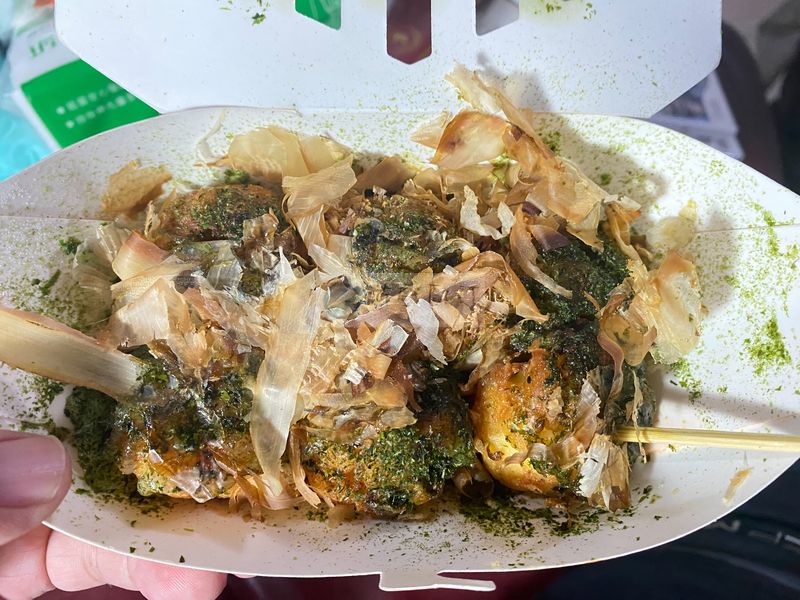日本國民美食:章魚燒
章魚燒(たこ焼き,Takoyaki)是源自日本大阪的著名小吃,是一種圓球形的麵糊點心,內部填入章魚塊、蔥花和其他配料,外表酥脆,內部則柔軟多汁。這道小吃歷史悠久,早在20世紀初便開始流行於關西地區,後來逐漸傳播至日本各地,甚至國際市場。
章魚燒起源於20世紀30年代,由大阪的餐廳會津屋創辦人遠藤留吉發明。他將一種名為「ラヂオ焼き」(Radio-yaki)的點心進行改良,原本的ラヂオ焼き以牛筋為主料,後來遠藤在其中加入章魚,並進一步完善了麵糊的配方,最終成為我們今日熟知的章魚燒。這道小吃隨著時間逐漸演變成關西特產之一,並成為大阪街頭不可或缺的風味。
章魚燒的最大特色在於它的口感與製作技術。外層焦脆,內部卻軟嫩香濃,當咬下一口時,可以感受到章魚的鮮美與麵糊的柔軟相互交織,再加上豐富的醬汁和鰹魚片的點綴,層次豐富且令人回味。通常章魚燒會搭配日式醬油或特製的章魚燒醬,再撒上海苔粉、柴魚片,並可添加美乃滋增添風味。
製作章魚燒時,需使用專門的章魚燒鐵板,該鐵板上有許多半圓形的小凹槽,這是章魚燒成型的關鍵工具。章魚燒的麵糊使用簡單的食材製成,但比例和技巧決定最終的成品質感。材料:
麵糊:一般由小麥粉、雞蛋和高湯調製而成,部分地區會加入山藥泥增添口感。高湯通常使用昆布或柴魚,這讓麵糊具備淡淡的鮮味。
內餡:內餡的主要食材是章魚塊。一般選用已經煮熟的章魚,將其切成小塊。此外還會加入蔥花、紅薑片(紅生薑)和天麩羅渣(天かす),這些配料都能增加口感和風味。
製作過程:
首先,要將麵糊倒入預熱過的章魚燒鐵板中,每個凹槽都需裝滿麵糊,因為隨後會加入章魚塊。接著,把切好的章魚塊放進每個麵糊凹槽的中心,再撒上蔥花、紅薑和天麩羅渣。這些配料除了能提升章魚燒的風味,還能讓內部的口感更加豐富多層次。
當麵糊開始凝固時,便可以用一根細長的竹籤或金屬針將章魚燒翻轉過來。這是製作章魚燒的關鍵技巧,翻轉得當,才能確保每顆章魚燒都能均勻受熱,外層酥脆,而內部軟嫩。經過數次翻轉後,待章魚燒呈現出金黃色且圓潤飽滿的形狀,就可以起鍋。
最後的裝盤與點綴
完成後的章魚燒通常會放在平盤上,並淋上章魚燒醬,這種醬料甜鹹適中,與章魚燒的風味相得益彰。隨後再擠上一些美乃滋,撒上海苔粉和柴魚片,這樣一盤外酥內軟、鮮香四溢的章魚燒便大功告成了。
章魚燒的流行使得不同地區出現各自的變化版本。在日本,除了傳統的章魚餡料外,還有一些地區喜歡加入蝦仁、起司、玉米粒等不同配料,甚至在國際上,還可以看到一些融合當地風味的版本,比如使用辣醬、芝士粉等調味。儘管口味多元,傳統的大阪風味章魚燒仍然最受喜愛。無論在街頭小吃攤,還是在居酒屋餐廳,章魚燒都是一道受歡迎的美食。大阪也有專門的章魚燒主題餐廳,遊客甚至可以參加章魚燒製作體驗,學習如何親手做出這道地道的關西美食。
總結來說,章魚燒是一道集美味、樂趣與技藝於一身的日本經典小吃,無論是自己動手製作,還是在攤販品嘗,都能感受到其獨特的風味魅力。
Takoyaki (たこ焼き, Takoyaki) is a famous snack that originated from Osaka, Japan. It is a ball-shaped savory dish made from batter, typically filled with octopus pieces, green onions, and other ingredients. The exterior is crispy, while the inside remains soft and juicy. This snack has a long history, gaining popularity in the Kansai region in the early 20th century before spreading throughout Japan and eventually internationally.
History and Origin of Takoyaki
Takoyaki was invented in the 1930s by Tomekichi Endo, the founder of a restaurant called Aizuya in Osaka. Endo modified a snack called Radio-yaki (ラヂオ焼き), which originally used beef tendon as its main ingredient. He replaced the beef tendon with octopus and perfected the batter recipe, eventually creating what we know today as takoyaki. Over time, this snack evolved into one of the specialties of the Kansai region, becoming a staple of Osaka’s street food culture.
Characteristics of Takoyaki
The key feature of takoyaki is its unique texture and cooking technique. The outer layer is crispy, while the inside remains soft and flavorful. With each bite, you can experience the freshness of the octopus blending with the smoothness of the batter. Topped with a rich sauce and bonito flakes, the flavors become even more complex and satisfying. Typically, takoyaki is served with either soy sauce or a special takoyaki sauce, sprinkled with seaweed powder and bonito flakes, and sometimes drizzled with mayonnaise for added richness.
How to Make Takoyaki
Takoyaki requires a special takoyaki griddle, which has numerous semi-spherical molds that help shape the takoyaki balls. Although the batter consists of simple ingredients, the ratio and technique used in preparing it determine the final texture and taste.
Ingredients:
Batter: The batter is usually made from wheat flour, eggs, and dashi (a Japanese soup stock). In some regions, grated yam is added to enhance the texture. Dashi is typically made from kombu (kelp) or bonito flakes, giving the batter a subtle umami flavor.
Filling: The main filling is octopus. Pre-cooked octopus is cut into small pieces, and additional ingredients such as green onions, pickled ginger, and tempura bits (known as tenkasu) are often added for extra texture and flavor.
Process: To start, heat the takoyaki griddle and fill each mold with the batter. The molds should be filled generously, as the batter will be used to encapsulate the octopus pieces. After pouring in the batter, place a piece of octopus in the center of each mold and sprinkle the green onions, pickled ginger, and tempura bits on top. These ingredients not only enhance the flavor but also contribute to the overall texture of the takoyaki.
As the batter begins to set, use a long bamboo skewer or a metal pin to carefully flip the takoyaki balls. This is a critical step in making takoyaki; by flipping them skillfully, you ensure that the takoyaki cooks evenly and develops a crispy outer layer while keeping the interior soft. After several rounds of flipping, the takoyaki balls will turn a golden brown and develop a perfectly round, plump shape.
Plating and Garnishing
Once the takoyaki is cooked, it is typically served on a flat plate. The takoyaki is generously drizzled with takoyaki sauce, which is sweet and savory, complementing the flavor of the takoyaki. A squeeze of mayonnaise is then added, followed by a sprinkle of seaweed powder and bonito flakes. The heat from the takoyaki causes the thin bonito flakes to dance on top, creating an appealing visual effect. The final result is a dish that is crispy on the outside, soft on the inside, and bursting with umami flavors.
Regional Variations and Innovative Flavors
The popularity of takoyaki has led to various regional adaptations. In Japan, while the traditional octopus filling is most common, some areas enjoy experimenting with different fillings such as shrimp, cheese, and corn. Internationally, some versions incorporate local flavors, with toppings like spicy sauces or cheese powder.
Despite the diverse range of flavors, the traditional Osaka-style takoyaki remains the most beloved. Whether served from street vendors or in izakayas (Japanese pubs), takoyaki continues to be a crowd favorite. In Osaka, there are even specialized takoyaki restaurants, where tourists can participate in making their own takoyaki and learn how to create this iconic Kansai dish from scratch.
In conclusion, takoyaki is a beloved Japanese snack that combines delicious flavors, fun cooking techniques, and rich history. Whether you make it at home or enjoy it from a street vendor, takoyaki offers a unique and delightful taste of Osaka’s culinary culture.

- 1
- 2
- 3
- 4
